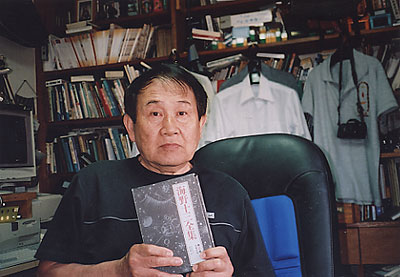June 30
June 30 is the day of the Wanuke shinto god festival. It
has long been said to rain on the festival day and the probability of rain
on the festival day is quite high. When I was a little child, I used to
hear the sound of flutes and drums of the festival and loved to visit the
shrine. However, for the past 20 years, I have never visited the shrine.
It no longer has that festival atmosphere I remember from my childhood.
The roadside stalls look quite ordinary and I would not feel like to mingle
with the crowd as I used to.
It didn't rain today, as bad luck stayed away from this year's
festival. I received an unusual present from a person in Sendai City. It
was a book called "The Martian Army" written by Juza Unno. It
was published more than 50 years ago and the story was first serialized
in a newspaper for young readers over a period of two years. I was in third
grade at elementary school, then. In those days they believed that life
existed on Mars. This was the first and memorable book that had introduced
me to astronomy. More than half a century later, a minor planet (12084)
discovered at Geisei was named "Unno" officially. In the story
a massive comet threatening the earth is nudged away at the last minute
by the moon's perturbation. Thrills and suspense fill mystery stories,
but Unno's works reflect his background as a scientist. Juza Unno is one
of the successors of Rampo Edogawa, a pioneering figure among Japanese
mystery writers. A monument dedicated to Unno stands in Tokushima Park
and the passage in praise of Unno's achievements was written by Rampo Edogawa
himself.
In my childhood I loved to read stories written by such writers
as Komatsu Kitamura, Yoichiro Minami, Minetaro Yamanaka among others. They
frequently wrote stories associated with the oceans and universe and thrilled
young readers.
Comet Morroe depicted in "The Martian Army" seems
to be modeled after Halley's Comet he saw in the Meiji Period.

Proudly holding Juza Unno's book "The Martian Army"

Juza Unno's "The Martian Army"
It's been quite a while since the start of the rainy season
was officially announced, but hasn't rained often. I frequently go to the
observatory to take advantage of dark skies after full moon, but the less-than
perfect weather disappoints me.
Comet Tuttle-Giacobini-Kresak is nearing perihelion. At the
comet's return in 1973 it was predicted to be 14th to 15th magnitude in
brightness, but near perihelion in June, it burst into 4th magnitude brightness.
The Smithsonian sent telegrams to various observatories asking for confirmation.
It turned out to be a sudden outburst of Tuttle-Giacobini-Kresak, not the
discovery of a new comet. However, this comet with a substantial tail was
not observed in Japan due to poor weather conditions during the rainy season.
Dr. Kresak of Czech Republic, one of the discoverers of this
comet, expressed his view on the outburst of this comet: "The comet
has probably spent most of its energy and it will be impossible to recover
it in the future." Five years later, in the fall of November 1978,
the comet was predicted to be at the 15th magnitude in the dawn sky. Geisei
recovered this comet at the predicted magnitude. It was very close to Venus
and at first I thought it to be a ghost image of Venus. However, this image
was confirmed to be that of the comet in subsequent observations. The comet
is now near perihelion in June, a similar position to that at the time
of the outburst in 1973. In spite of bright moon, I have been watching
this comet in anticipation of a similar outburst, but the comet is still
at 14th magnitude and moving away quickly.
As it is getting hot, I put on a shirt Mr. Muraoka brought
back for me from Egypt on his eclipse trip. The symbols printed on the
shirt read "Seki".




